
BACKGROUNDER
No. 3472 | APRIL 6, 2020
RICHARD AND HELEN DEVOS CENTER FOR RELIGION AND CIVIL SOCIETY
This paper, in its entirety, can be found at http://report.heritage.org/bg3472
The Heritage Foundation | 214 Massachusetts Avenue, NE | Washington, DC 20002 | (202) 546-4400 | heritage.org
Nothing written here is to be construed as necessarily reflecting the views of The Heritage Foundation or as an attempt to aid or hinder the passage of any bill before Congress.
Planned Parenthood by the Numbers
Melanie Israel
Planned Parenthood is a billion-dollar
abortion business and political machine,
with an increasing market share of total
annual abortions in the United States.
KEY TAKEAWAYS
Planned Parenthood’s reported financial
data reveals that net assets, government
funding sources, and private contribution
sources continue to rise every year.
In the same time, other areas—such as
prenatal services, cancer screening and
prevention services, and contraception
clients—show a dramatic decline.
I
n the spring of 2019, Planned Parenthood
abruptly announced that its president, Dr. Leana
Wen, would leave the helm of America’s abortion
giant. The first doctor at the head of the organization
in five decades, she was on the job for less than one
year after taking over following the departure of
Cecile Richards in 2018.
In the ensuing fallout, dueling messages from
Wen and Planned Parenthood insiders oered very
dierent reasons for her unceremonious ouster. Rank-
and-file staers told various media outlets that the
problem largely boiled down to management style and
political naivete. Wen, on the other hand, claims the
issue lay in “philosophical dierences over the direc-
tion and future of Planned Parenthood”; specifically,
abortion—and whether Planned Parenthood should
primarily cast it as a health care issue rather than a
political issue. Wen, an emergency room physician

APRIL 6, 2020 | 2
BACKGROUNDER | No. 3472
heritage.org
herself, preferred the former, and the Board of Directors preferred the latter,
ultimately voting unanimously to relieve her of her duties.
Planned Parenthood then named Alexis McGill Johnson as the acting head
of Planned Parenthood Federation of America, as well as the organization’s
political arm, Planned Parenthood Action Fund. In the announcement, Planned
Parenthood celebrated McGill Johnson as a “renowned social justice leader,
lifelong political organizer, and a tireless advocate for reproductive rights.”
While the general public is not privy to the organization’s internal deliber-
ations, the dueling messaging battle during Wen’s departure, combined with
the background of the interim president, appears to be signaling that Planned
Parenthood will search for a Richards-esque politico to lead the organization.
Internal conversations about leadership and strategy aside, the public is
privy to medical and financial information that Planned Parenthood pro-
vides each year in its annual reports, as well as data from government and
other private sources. This publicly available data—specifically data from
Cecile Richards’ 12-year tenure—provide insight about the organization’s
priorities as the search for a new leader commences in 2020.
Planned Parenthood Medical Services
In each annual report, Planned Parenthood publishes yearly totals for
a variety of categories, from contraception clients to cancer screening
and prevention services. These data points are revealing as a single-year
snapshot—but they are even more revealing when placed in context of
previous years.
Contraception
The number of Planned Parenthood’s contraception clients decreased
almost every year of Cecile Richards’ tenure, and dramatically so in the
past five years.
Starting in 2008, Planned Parenthood began providing a more specific
breakdown of the methods of contraception chosen by clients. At that
point, a reported 2.9 percent chose an intra-uterine device (IUD). By the
2017–2018 report, 22.1 percent of contraception clients were choosing
long-acting methods, such as IUDs and implants. The years 2008 to 2012
saw a steady increase that then became more dramatic in the following
years. It is possible that part of the reason Planned Parenthood is serving
fewer contraception clients in recent years is associated with the dramatic
uptick in the number of clients choosing long-acting contraception methods
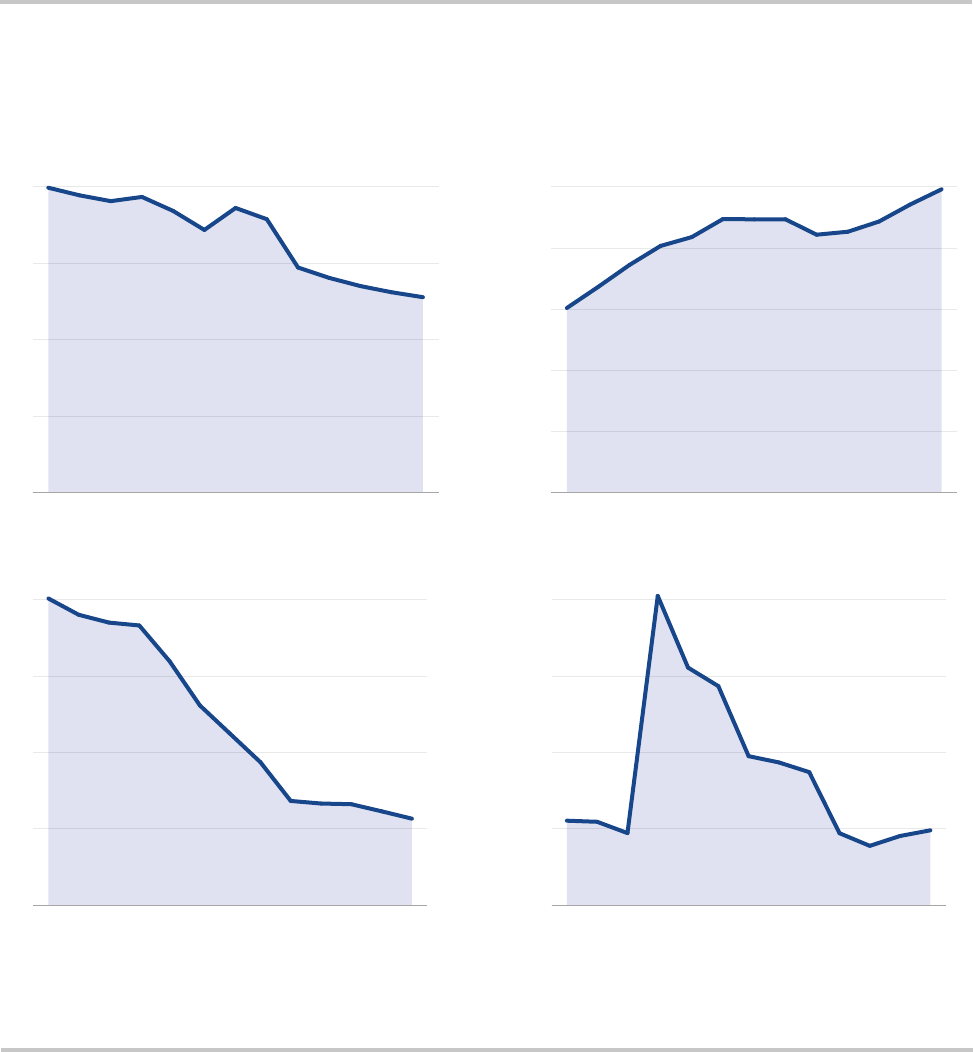
APRIL 6, 2020 | 3
BACKGROUNDER | No. 3472
heritage.org
(who, presumably, do not need to return to Planned Parenthood as often to
renew a prescription or obtain a new device).
STD/STI Testing and Treatment
Unlike contraception clients, Planned Parenthood gradually increased
the total number of STD/STI (sexually transmitted diseases/sexually
BG3472 A heritage.org
SOURCE: Author’s analysis of Planned Parenthood annual reports, 2006–2019.
See the appendix for more information.
CONTRACEPTION CLIENTS (MILLIONS) STD-STI CLIENTS (MILLIONS)
CANCER SCREENING CLIENTS (MILLIONS)
PRENATAL CLIENTS
CHART 1
Planned Parenthood’s Non-Abortion Clients

APRIL 6, 2020 | 4
BACKGROUNDER | No. 3472
heritage.org
transmitted infections) testing and treatment clients during the Richards
tenure by 64 percent.
Cancer Screening/Prevention Services
Planned Parenthood is providing fewer than one-third of the cancer
screening and prevention services it reported performing at the beginning
of Cecile Richards’ tenure.
Notably, in 2012 (amidst a dramatic drop in Planned Parenthood’s reported
services), the Susan G. Komen Foundation announced that it would no longer
provide grants for breast cancer screening and educational programs at
Planned Parenthood clinics. In a press release responding to the announce-
ment, Planned Parenthood claimed that it performs roughly 750,000 breast
cancer screenings annually, roughly half of 2011’s total reported services.
1
Planned Parenthood reportedly received $700,000 in one year from the Komen
foundation.
2
The foundation’s decision to sever ties, however, was short-lived in
the face of intense media scrutiny and protests from Planned Parenthood and
its allies: Funding was restored within days (on top of the $3 million Planned
Parenthood announced it had raised in osetting funds in the meantime).
3
Despite
the bluster, overall services continued to decline in subsequent years.
Prenatal Clients/Services
As explained in Americans United for Life’s (AUL’s) special report, “The
New Leviathan”:
Perhaps in an eort to mask the growing disparity, Planned Parenthood
switched, in 2009, from reporting “prenatal clients” to reporting “prenatal ser-
vices.” While Planned Parenthood no longer provides an exact figure of prenatal
clients, conclusions can be drawn using PPFA’s [Planned Parenthood Federation
of America’s] reported 2009 figures. Planned Parenthood reported both 7,021
prenatal clients and 40,489 prenatal services in 2009. That would average to
5.77 services for each pregnant woman. Applying that ratio to its 2013 numbers,
PPFA’s 18,684 prenatal services included approximately 3,240 prenatal clients—a
more than 80% decline from the 17,610 prenatal clients its clinics saw in 2004.
4
Applying the same ratio to 2018 numbers, Planned Parenthood’s 9,798
prenatal services included roughly 1,700 prenatal clients—a nearly 50 per-
cent decline from AUL’s 2013 estimate and a shocking 90 percent decline
from their 2004 calculation.
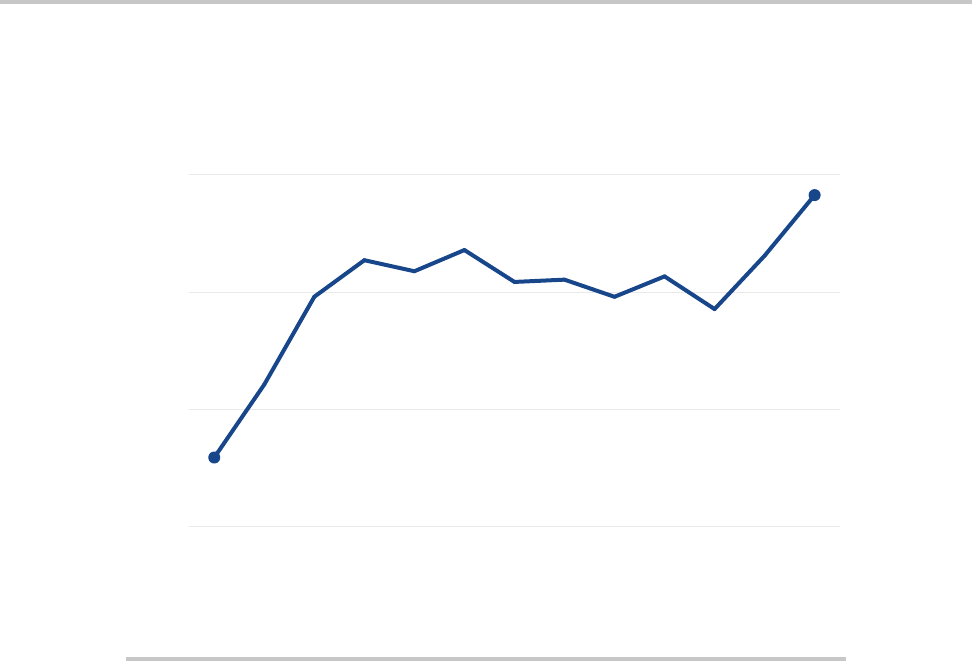
APRIL 6, 2020 | 5
BACKGROUNDER | No. 3472
heritage.org
Abortions at Planned Parenthood
After several years of a dramatic increase in the number of abortions
performed in the initial years of Richards’ tenure, the numbers remained
generally stable and then declined slightly. After 2016, Planned Parenthood
began reporting dramatic upticks again. The 345,672 abortions in 2018 was
the highest number of abortions reported during Cecile Richard’s tenure.
The decrease in abortions at Planned Parenthood between 2011 and 2016
should be noted in light of additional context.
Analysis by the pro-abortion Guttmacher Institute, which performs peri-
odic nationwide surveys of abortion clinics, indicates that between 2011
and 2014 the number of clinics that provide abortions in the United States
declined 6 percent, and then increased by 2 percent between 2014 and 2017.
5
In 2016 during President Barack Obama’s final year in oce, the Food
and Drug Administration (FDA) changed the approved regimen for the
chemical abortion drug mifepristone (also known under the brand name
Mifeprex). The drug originally came on the market in the United States
after much controversy in 2000, and in 2016 the Obama Administration
FDA loosened the standards for the use of the drug by changing its Risk
BG3472 A heritage.org
SOURCE: Author’s analysis of Planned Parenthood annual reports,
2006–2019. See the appendix for more information.
CHART 2
Planned Parenthood Abortions Have Been Increasing
NUMBER OF ABORTIONS
345,672
289,750
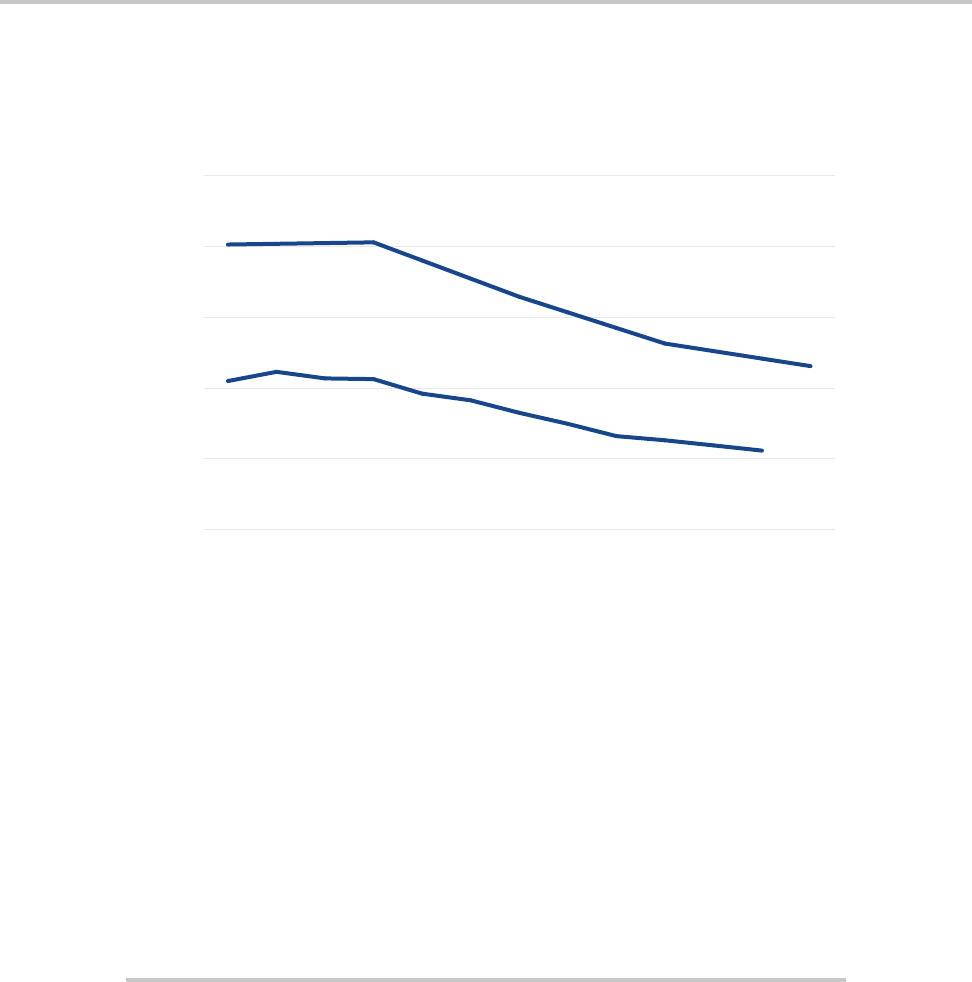
APRIL 6, 2020 | 6
BACKGROUNDER | No. 3472
heritage.org
Evaluation and Mitigation Strategy.
6
Notably, the spike in Planned Parent-
hood’s reported abortion numbers occurs after this change.
Further analysis by the Guttmacher Institute indicated that between
2014 and 2017, the incidence of chemical abortion increased by 25 percent,
comprising nearly 40 percent of all abortions nationwide in 2017—the year
abortions performed by Planned Parenthood began increasing once again,
immediately following the FDA’s decision to loosen standards governing
mifepristone’s regimen.
CHART 3
Total Abortions Have Been Declining
NUMBER OF ABORTIONS
BG3472 A heritage.org
SOURCES:
Guttmacher Institute data:
• Rachel K. Jones and Jenna Jerman, “Abortion Incidence and Service Availability in the United States, 2011,”
Guttmacher Institute, February 3, 2014, https://onlinelibrary.wiley.com/doi/full/10.1363/46e0414 (accessed January
24, 2020).
• Rachel K. Jones and Jenna Jerman, “Abortion Incidence and Service Availability in the United States, 2014,”
Guttmacher Institute, March 2017, https://www.guttmacher.org/journals/psrh/2017/01/abortion-incidence-and-
service-availability-united-states-2014 (accessed January 24, 2020).
• Rachel K. Jones, Elizabeth Witwer, and Jenna Jerman, “Abortion Incidence and Service Availability in the United
States, 2017,” Guttmacher Institute, September 2019, https://www.guttmacher.org/report/abortion-incidence-
service-availability-us-2017 (accessed January 24, 2020).
CDC data: Centers for Disease Control and Prevention, Abortion Surveillance Reports, 2005–2016,
https://www.cdc.gov/reproductivehealth/data_stats/abortion.htm (accessed January 24, 2020).
For more information, see the appendix.
Guttmacher
Institute data
CDC data

APRIL 6, 2020 | 7
BACKGROUNDER | No. 3472
heritage.org
Abortion, Nationwide
CDC. The Centers for Disease Control and Prevention (CDC) issues an
annual report of abortion surveillance in the United States by collecting
data that states submit on a voluntary basis. (States with a high incidence of
abortion, such as California and New York, do not submit data to the CDC.)
When released, the surveillance reports discuss reporting numbers from
three years prior. (For example, in 2019 the CDC released abortion data
from 2016.) Because reporting is not mandatory, and the data is several
years out of date, these surveillance reports are a somewhat helpful—but
unfortunately incomplete—snapshot of abortion incidence in the United
States. That said, the data shows a consistent decline in the number of abor-
tions overall, in contrast to the increasing number of abortions at Planned
Parenthood clinics specifically.
Guttmacher Institute. The Guttmacher Institute—formerly the research
arm of Planned Parenthood but now a separate entity—periodically conducts
nationwide surveys of abortion providers throughout the country, not just
Planned Parenthood clinics. Guttmacher data encompass more respondents
than CDC data, although these surveys are done every three years, rather than
annually. Still, both the Guttmacher Institute and the CDC demonstrate that
the number of abortions continues to decline annually.
Planned Parenthood’s Market Share of Abortion
Nationwide, the overall abortion rate—according to both the CDC and
the Guttmacher Institute—is declining. However, abortions at Planned Par-
enthood are increasing—and so is the organization’s market share. In 2005,
Planned Parenthood accounted for 32 percent of abortions reported by the
CDC and 52 percent of abortions in 2016. In 2005, Planned Parenthood
accounted for 22 percent of abortions reported by the Guttmacher Institute
and 39 percent in 2017.
7
Planned Parenthood Financial Data
In addition to releasing information about medical data each year,
Planned Parenthood releases annual financial data as well. This financial
information is for the Planned Parenthood Federation of America, a 501(c)
(3), not to be confused with the Planned Parenthood Action Fund, which is
the organization’s political action committee.
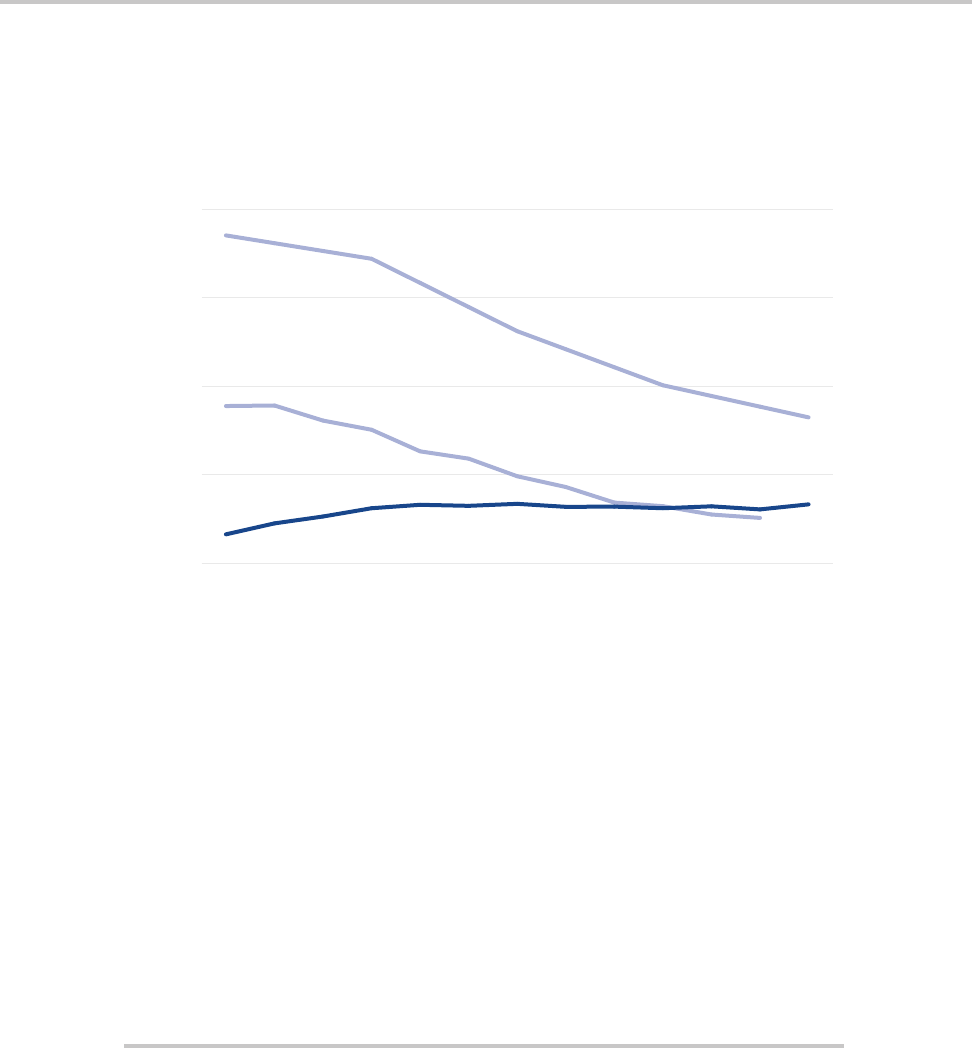
APRIL 6, 2020 | 8
BACKGROUNDER | No. 3472
heritage.org
Excess Revenue
Planned Parenthood’s reported excess revenue over expenses varied over
the course of Cecile Richards’ tenure, although it dramatically increased
in recent years. During her final year as the head of Planned Parenthood,
excess revenue was nearly five times greater than what it was at the start
of her tenure.
CHART 4
Planned Parenthood Performing Larger Share
of Total Abortions
NUMBER OF ABORTIONS
Non-PP Abortions
(Guttmacher
Institute data)
Non-PP Abortions
(CDC data)
PP Abortions
BG3472 A heritage.org
SOURCES:
Planned Parenthood data: Heritage Foundation analysis of Planned Parenthood annual reports, 2006–2019.
Guttmacher Institute data:
• Rachel K. Jones and Jenna Jerman, “Abortion Incidence and Service Availability in the United States, 2011,”
Guttmacher Institute, February 3, 2014, https://onlinelibrary.wiley.com/doi/full/10.1363/46e0414 (accessed January
24, 2020).
• Rachel K. Jones and Jenna Jerman, “Abortion Incidence and Service Availability in the United States, 2014,”
Guttmacher Institute, March 2017, https://www.guttmacher.org/journals/psrh/2017/01/abortion-incidence-and-
service-availability-united-states-2014 (accessed January 24, 2020).
• Rachel K. Jones, Elizabeth Witwer, and Jenna Jerman, “Abortion Incidence and Service Availability in the United
States, 2017,” Guttmacher Institute, September 2019, https://www.guttmacher.org/report/abortion-incidence-
service-availability-us-2017 (accessed January 24, 2020).
CDC data: Centers for Disease Control and Prevention, Abortion Surveillance Reports, 2005–2016,
https://www.cdc.gov/reproductivehealth/data_stats/abortion.htm (accessed January 24, 2020).
For more information, see the appendix.
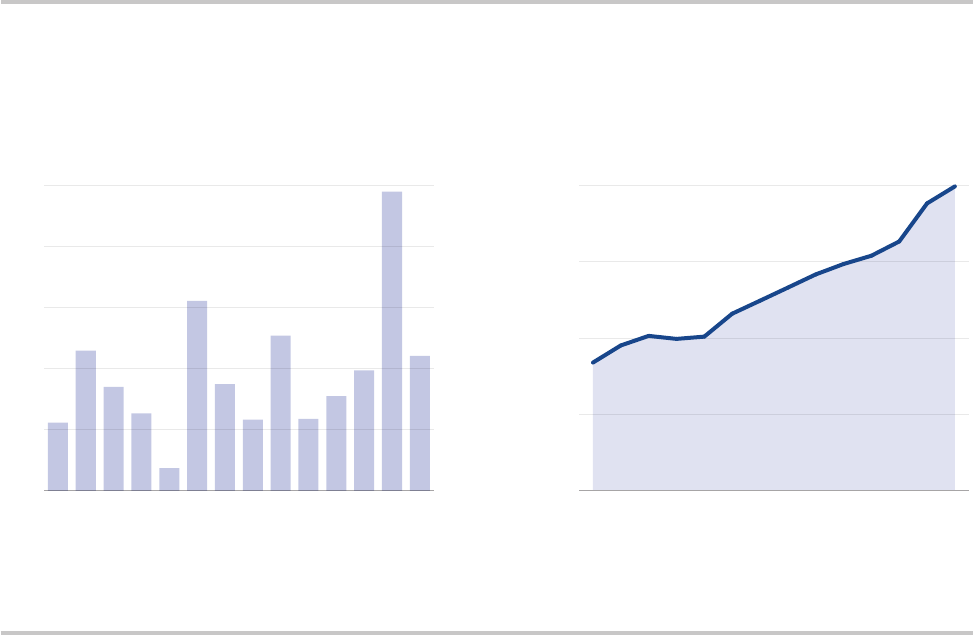
APRIL 6, 2020 | 9
BACKGROUNDER | No. 3472
heritage.org
Net Assets
While excess revenue varied from year to year, Planned Parenthood’s net
assets consistently increased throughout the course of Richards’ tenure, and
more than doubled between her arrival in 2006 and her departure in 2018.
Government Funding
Planned Parenthood’s government funding nearly doubled over the
course of Richards’ tenure. As of 2018, Planned Parenthood received over
one-half billion taxpayer dollars annually.
Private Funding
Planned Parenthood received three times the number of private contribu-
tions in 2018 than it received in 2006, when Cecile Richards arrived. In recent
years, the number of active individual contributors has increased dramatically
after remaining relatively stable for most of Richards’ tenure. Although Planned
Parenthood receives millions of dollars in bequests each year, those dollars make
up a relatively small amount of the overall of private contributions.
CHART 5
Key Planned Parenthood Financial Indicators
EXCESS REVENUE (MILLIONS)
NET ASSETS (BILLIONS)
BG3472 A heritage.org
SOURCE: Author’s analysis of Planned Parenthood annual reports, 2006–2019.
See the appendix for more information.
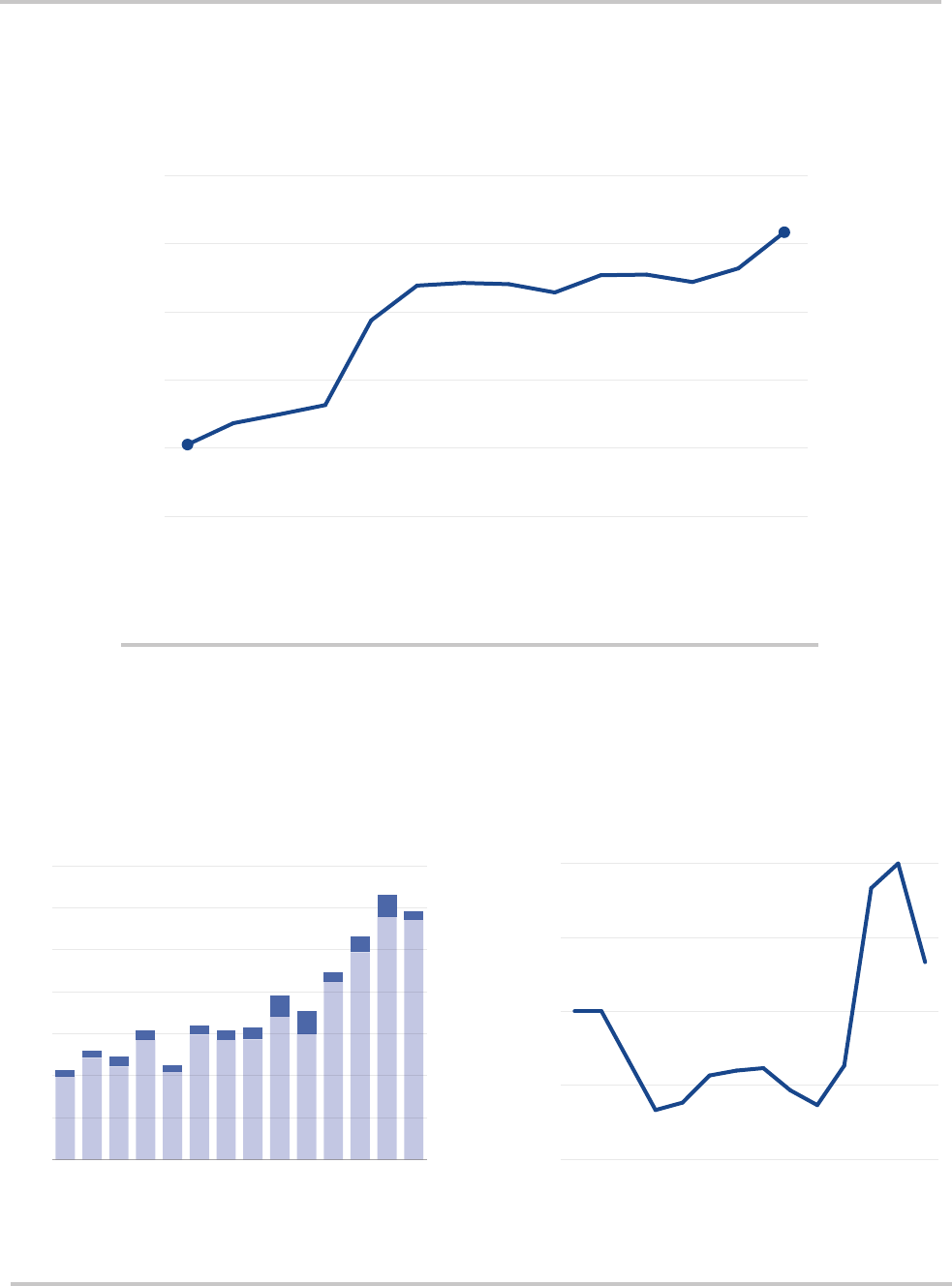
APRIL 6, 2020 | 10
BACKGROUNDER | No. 3472
heritage.org
PRIVATE FUNDING (MILLIONS)
■ Bequests ■ All Other
CHART 7
Planned Parenthood’s Private Funding
BG3472 A heritage.org
SOURCE: Author’s analysis of Planned Parenthood annual reports, 2006–2019.
See the appendix for more information.
ACTIVE INDIVIDUAL CONTRIBUTORS (MILLIONS)
IN MILLIONS OF DOLLARS
CHART 6
Planned Parenthood’s Government Funding
BG3472 A heritage.org
SOURCE: Author’s analysis of Planned Parenthood annual reports,
2006–2019. See the appendix for more information.
$305 million
$617 million
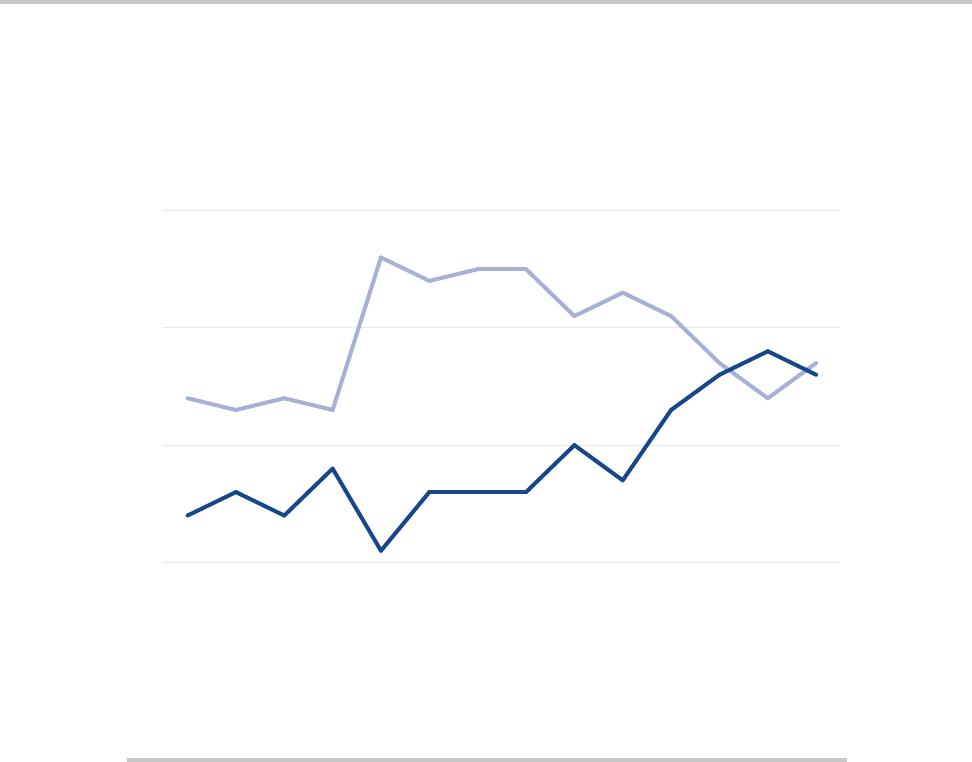
APRIL 6, 2020 | 11
BACKGROUNDER | No. 3472
heritage.org
BG3472 A heritage.org
NOTE: Not all sources of revenue are shown, such as operating revenue and support from aliates.
SOURCE: Author’s analysis of Planned Parenthood annual reports, 2006–2019. See the appendix for
more information.
AS A SHARE OF OVERALL REVENUE
CHART 8
Private Donations to Planned Parenthood Nearly Equal
Government Funding
❙
Private
❙
Government
Revenue Comparisons
During the course of Richards’ tenure, private contributions made a
steady increase in the percentage of Planned Parenthood’s overall reve-
nue. In contrast, the percentage of government funding contributing to
Planned Parenthood’s overall revenue peaked 10 years ago and has steadily
declined since then.
Conclusion
Planned Parenthood leadership has indicated that, in light of Dr. Leana
Wen’s departure, the organization will continue to lean into abortion politics.
During Cecile Richards’ tenure, Planned Parenthood commanded an increasing
share of the overall U.S. abortion market—nearly doubling both the number
of active individual contributors and the amount of government funding it
receives, as well as seeing an increase in private donations by nearly 200 percent.

APRIL 6, 2020 | 12
BACKGROUNDER | No. 3472
heritage.org
Should Planned Parenthood appoint a Richards-esque leader, Ameri-
cans can expect more of the same: more abortions; more of their tax dollars
funding Planned Parenthood’s activities; and declining numbers of prenatal
services, cancer screening and prevention services, and contraception cli-
ents served at Planned Parenthood.
Melanie Israel is Research Associate in the Richard and Helen DeVos Center for Religion
and Civil Society, of the Institute for Family, Community, and Opportunity, at The
Heritage Foundation.

APRIL 6, 2020 | 13
BACKGROUNDER | No. 3472
heritage.org
Appendix A: Planned Parenthood
Annual Reports, 2006–2019
2005–2006 Annual Report: Planned Parenthood Federation of
America, “Annual Report: 2005–2006,” https://liveaction.org/research/
wp-content/uploads/2011/06/2005-2006-Planned-Parenthood-Annu-
al-Report.pdf (accessed February 20, 2020)
2006–2007 Annual Report: Planned Parenthood Federation of
America, “Annual Report: 2006–2007,” https://liveaction.org/research/
wp-content/uploads/2011/06/2006-2007-Planned-Parenthood-Annu-
al-Report.pdf (accessed February 20, 2020).
2007–2008 Annual Report: Planned Parenthood Federation of
America, “Annual Report: 2007–2008,” https://www.liveaction.org/news/
wp-content/uploads/2017/04/2007-2008-Planned-Parenthood-Annu-
al-Report.pdf (accessed February 20, 2020)
2008–2009 Reports: Planned Parenthood Federation of
America, “Annual Report: 2008–2009,” https://www.scribd.com/docu-
ment/49124420/Planned-Parenthood-Annual-Report-08-09 (accessed
February 20, 2020). See also Planned Parenthood Federation of Amer-
ica, “Fact Sheet: Planned Parenthood Services,” September 2010, https://
liveaction.org/research/wp-content/uploads/2011/06/2008-2009-
Planned-Parenthodo-Factsheet.pdf (accessed February 20, 2020).
2009–2010 Annual Report: Planned Parenthood Federation of
America, “Annual Report: 2009–2010,” https://liveaction.org/research/
wp-content/uploads/2011/06/2009-2010-Planned-Parenthood-Annu-
al-Report.pdf (accessed February 20, 2020).
2010–2011 Annual Financial Report: Planned Parenthood Federa-
tion of America, “Annual Financial Report: 2010–2011,” https://issuu.com/
actionfund/docs/ppfa_ar_2011_110112_vf (accessed February 20, 2020).
2011–2012 Annual Report: Planned Parenthood Federation of Amer-
ica, “Annual Report: 2011–2012,” https://www.plannedparenthood.org/
files/4913/9620/1413/PPFA_AR_2012_121812_vF.pdf (accessed February 20, 2020).
2012–2013 Annual Report: Planned Parenthood Federation of Amer-
ica, “Annual Report: 2012–2013,” https://www.plannedparenthood.org/
files/7413/9620/1089/AR-FY13_111213_vF_rev3_ISSUU.pdf (accessed
February 20, 2020).
2013–2014 Annual Report: Planned Parenthood Federation of Amer-
ica, “2013–2014 Annual Report,” https://www.plannedparenthood.org/
files/6714/1996/2641/2013-2014_Annual_Report_FINAL_WEB_VERSION.
pdf (accessed February 20, 2020).

APRIL 6, 2020 | 14
BACKGROUNDER | No. 3472
heritage.org
2014–2015 Annual Report: Planned Parenthood Federation of Amer-
ica, “2014–2015 Annual Report,” https://www.plannedparenthood.org/
files/2114/5089/0863/2014-2015_PPFA_Annual_Report_.pdf (accessed
February 20, 2020).
2015–2016 Annual Report: Planned Parenthood Federation of America,
“2015–2016 Annual Report,” https://www.plannedparenthood.org/uploads/
filer_public/18/40/1840b04b-55d3-4c00-959d-11817023c8/20170526_
annualreport_p02_singles.pdf (accessed February 20, 2020).
2016–2017 Annual Report: Planned Parenthood Federation of America,
“2016–2017 Annual Report,” https://www.plannedparenthood.org/uploads/
filer_public/71/53/7153464c-8f5d-4a26-bead-2a0dfe2b32ec/20171229_
ar16-17_p01_lowres.pdf (accessed February 20, 2020).
2017–2018 Annual Report: Planned Parenthood Federation of Amer-
ica, “2017–2018 Annual Report,” https://www.plannedparenthood.org/
uploads/filer_public/80/d7/80d7d7c7-977c-4036-9c61-b3801741b441/19
0118-annualreport18-p01.pdf (accessed February 20, 2020).
2018–2019 Annual Report: Planned Parenthood Federation of America,
“Annual Report:2018–2019,” https://www.plannedparenthood.org/uploads/
filer_public/2e/da/2eda3f50-82aa-4ddb-acce-c2854c4ea80b/2018-2019_
annual_report.pdf (accessed February 20, 2020).

APRIL 6, 2020 | 15
BACKGROUNDER | No. 3472
heritage.org
Endnotes
News release, “‘Alarmed and Saddened’ by Komen Foundation Succumbing to Political Pressure, Planned Parenthood Launches Fund for Breast
Cancer Services,” Planned Parenthood Federation of America, January 31, 2012, https://www.plannedparenthood.org/about-us/newsroom/press-
releases/alarmed-saddened-komen-foundation-succumbing-political-pressure-planned-parenthood-launches-fun (accessed February 3, 2020).
Pam Belluck, “Cancer Group Halts Financing to Planned Parenthood,” New York Times, January 31, 2012, https://www.nytimes.com/2012/02/01/us/
cancer-group-halts-financing-to-planned-parenthood.html?_r=1&hpw (accessed February 3, 2020).
News release, “Komen Foundation Restores Funding for Breast Cancer Screenings at Planned Parenthood Health Centers,” Planned Parenthood
Federation of America, February 3, 2012, https://www.plannedparenthood.org/about-us/newsroom/press-releases/komen-foundation-restores-
funding-for-breast-cancer-screenings-at-planned-parenthood-health-centers (accessed February 3, 2020).
Americans United for Life, “The New Leviathan: The Mega-Center Report; How Planned Parenthood Has Become Abortion, Inc.,” 2015, https://aul.org/
wp-content/uploads/2018/11/AUL-Mega-Center-Report-06-24-2015.pdf (accessed February 3, 2020).
Rachel K. Jones, Elizabeth Witwer, and Jenna Jerman, “Abortion Incidence and Service Availability in the United State, 2017,” Guttmacher Institute,
September 2019, https://www.guttmacher.org/report/abortion-incidence-service-availability-us-2017 (accessed February 3, 2020)
Christopher H. Smith, et al., Letter to Robert M. Cali, April 25, 2016, https://www.cruz.senate.gov/files/documents/Letters/20160426_
SmithLankfordLettertoFDAonAbortionDrug.pdf (accessed February 3, 2020).
These percentages are based on the comparison between Planned Parenthood’s total abortion reported and the CDC or Guttmacher’s total in a given
year. Keeping in mind that Planned Parenthood could be reporting abortions in states that do not report to the CDC, and Planned Parenthood clinics
may or may not respond to the Guttmacher survey, these percentages provide a general estimation rather than an exact calculation.
